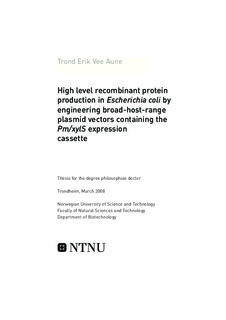| dc.contributor.author | Aune, Trond Erik Vee | nb_NO |
| dc.date.accessioned | 2014-12-19T13:14:07Z | |
| dc.date.available | 2014-12-19T13:14:07Z | |
| dc.date.created | 2008-04-14 | nb_NO |
| dc.date.issued | 2008 | nb_NO |
| dc.identifier | 124074 | nb_NO |
| dc.identifier.isbn | 978-82-471-7362-6 | nb_NO |
| dc.identifier.uri | http://hdl.handle.net/11250/245579 | |
| dc.description.abstract | The use of recombinant gene expression for industrial protein production has since the early 1970s become a multi-billion industry. Despite many years of intensive research, no universal expression system exists that can be used for high-level industrial production of any given recombinant gene. Because of this, much work must be done prior to production to identify the ideal production organism for the gene of interest, usually followed by optimization of an expression system useful in this organism.
One of the most popular production organisms is the gram-negative bacterium Escherichia coli, which is regularly used for high-level production of both prokaryotic and eukaryotic proteins. Despite its popularity there are some well-known drawbacks of using E. coli for recombinant expression, including lack of some post-translational modifications of recombinant proteins, and few and inefficient systems for translocation and secretion.
In the present work selected key processes in E. coli recombinant protein production has been studied with focus on exploring methods to improve protein production in this organism. The key processes include the use of signal peptides for efficient translocation of eukaryotic proteins to the periplasm, directed evolution of the transcription regulators for increased expression from their cognate promoters, and the use of codon-optimized synthetic genes.
The use of signal peptides to achieve efficient translocation of recombinant genes is a well-known and common method. By testing the signal peptides sequences ompA, pelB and the novel, designed consensus signal peptide sequence CSP, in combination with the eukaryotic cDNA for the proteins hGM-CSF, scFv-phOx and hIFN-α2b, it was shown that the effect of signal peptides are gene-specific and, more importantly, that the presence of signal peptides not only directs the gene products to the periplasm but also increases the expression of the recombinant genes. Under high cell density culture (HCDC) expression production volumes of 2.3, 1.7 and 0.6 g/L of scFv-phOx, hGM-CSF and hIFN-α2b, respectively, were obtained. | nb_NO |
| dc.language | eng | nb_NO |
| dc.publisher | Fakultet for naturvitenskap og teknologi | nb_NO |
| dc.relation.ispartofseries | Doktoravhandlinger ved NTNU, 1503-8181; 2008:70 | nb_NO |
| dc.relation.haspart | Sletta, H; Nedal, A; Aune, T.E.V; Hellebust, H; Hakvåg, S; Aune, R; Ellingsesn, T.E; Valla, S; Brautaset, T. Broad-Host-Range Plasmid pJB658 Can Be Used for Industrial-Level Production of a Secreted Host-Toxic Single-Chain Antibody Fragment in Escherichia coli. Appl Environ Microbiol. 70(12): 7033-7039, 2004. | nb_NO |
| dc.relation.haspart | Sletta, H; Tøndervik, A; Hakvåg, S; Aune, T.E.V; Nedal, A; Aune, R; Evensen, G; Valla, S; Ellingsesn, T.E; Brautaset, T. The Presence of N-Terminal Secretion Signal Sequences Leads to Strong Stimulation of the Total Expression Levels of Three Tested Medically Important Proteins during High-Cell-Density Cultivations of Escherichia coli. Appl. Environ. Microbiol.. 73(3): 906-912, 2007. | nb_NO |
| dc.relation.haspart | Aune, T.E.V; Bekke, I; Drabløs, F; Lale, R; Brautaset, T; Valla, S. Directed Evolution of the Transcription Factor XylS for Development of Improved Expression Systems. . | nb_NO |
| dc.relation.haspart | Aune, T.E.V; Stüttgen, F; Lale, R; Valla, S. A synthetic version of the Pseudomonas putida xylS gene designed for optimal expression in Escherichia coli has a strongly reduced translation efficiency caused by mutations in the 5’ part of the coding sequence. . | nb_NO |
| dc.title | High level recombinant protein production in Escherichia coli by engineering broad-host-range plasmid vectors containing the Pm/xylS expression cassette | nb_NO |
| dc.type | Doctoral thesis | nb_NO |
| dc.contributor.department | Norges teknisk-naturvitenskapelige universitet, Fakultet for naturvitenskap og teknologi, Institutt for bioteknologi | nb_NO |
